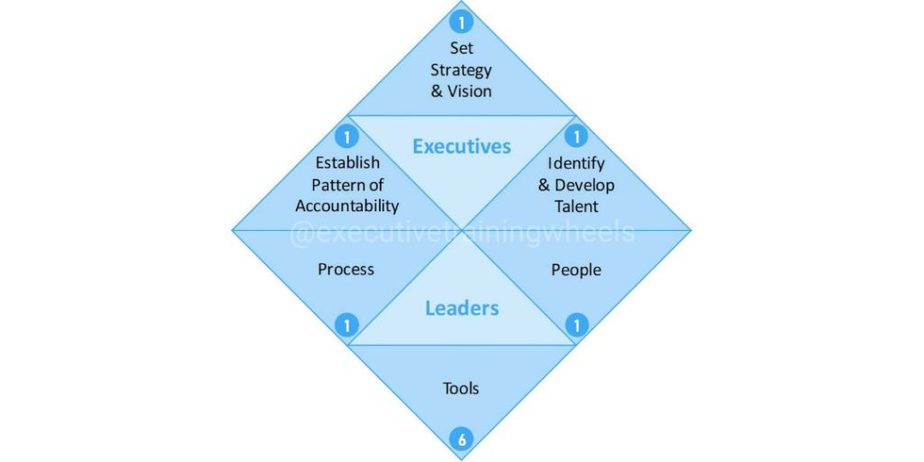What is Executive Leadership?
Before defining executive leadership let’s quickly review what all leaders are responsible for. Nearly everyone in business has at some point seen or drawn the ubiquitous “People, Process, Tools” triangle, or some close variant of it. It’s a useful way of quickly breaking down the types of things leaders are responsible for.

This site will focus far more on people and process than on tools. Tools can help substantially, but it’s people and process that will make or break you. No company becomes a success simply because of the tools it uses. Some companies find success from the tools they create, but that’s a different story.
What I see discussed much less often is how to break down what Executive Leadership consists of. We can construct a similarly simple view of executive responsibilities:

This breaks down the scope of executive leadership into the 3 main areas related to actually running an organization. Being the public face of the brand is left separate. I accidentally designed this view years ago when I misremembered some of Ron Schmidt’s research. For reasons that will be clear shortly, I prefer this modified version.
Set Strategy and Vision is fairly obvious and straightforward. It is up to the executive in any executive role to determine where their organization should be headed, why, when, and at a high level how to get there. There’s a lot more to be said about strategy. For now, suffice to say it certainly belongs in any executive’s purview.
Identify & Develop Talent is the first crucial means by which an executive can have any hope of achieving their vision. An executive who can’t identify talent effectively is doomed to being surrounded by the wrong people. As the needs of an organization grow and change, so too do the demands on its people. Executives need to be able to continuously develop people, or any growth will be unsustainable.
Establish a Pattern of Accountability has multiple facets. This is what is often referred to as an organization’s “culture,” though this wording allows us to be more specific. How are decision rights defined and allocated? Are authority and responsibility well matched? How is performance evaluated and rewarded? These are critical attributes of an organization, and an executive is responsible for all of them.
It’s possible to get a quicker, more intuitive understanding of this view of tripartite executive responsibility by marrying it with the People, Process, Tools triangle so many people are already familiar with:

By rotating the People, Process, Tools triangle that breaks down leaders’ areas of responsibility, we can view it as a reflection of executives’ responsibility. Identifying and developing talent is at the heart of leading people. Likewise, much of the purpose of establishing a pattern of accountability is to ensure that proper business processes are employed.
These similarities do not erase the gap between what’s expected of executives vs. what’s expected of mid level leaders. There are elements of scale at play on the executive end that do not apply elsewhere. Just as common as the People, Process, Tools triangle is the phrase “you lead people, you manage a process.” I agree wholeheartedly with this phrase, and at the executive level it can be extended further. It is the responsibility of executives to identify talent well enough and at such scale that said talent in turn leads people. In the same vein, it is the responsibility of executives to establish a pattern of accountability in which the right processes are found and followed even in the absence of direct management.
The Tools element of the Leaders triangle does not as clearly reflect the Set Strategy and Vision element at the top of the Executive triangle. This is ok, as it gives us a hint on how to properly prioritize these 6 areas of focus for most organizations:

To borrow a page from Tim Grover, who lists 13 #1 attributes of the highly effective people he refers to as “Cleaners,” leadership teams have the following priorities:
#1 is for executives to set the strategy and vision.
#1 is for executives to identify and develop talent to pursue that vision.
#1 is for executives to establish a pattern of accountability in which that vision is pursued by that talent.
#1 is for leaders to ensure the right people are in the right roles and are able to be effective.
#1 is for leaders to align on the right processes for their people to follow and execute.
Finally, #6 is for leaders to ensure their people have the right tools for the job.
These priorities follow a very simple logic. In the above, as with many things in life, skipping or failing on priority #6, while potentially costly, is just not that devastating. But skipping or failing to come through on priority #1 will eventually cost everything.
In the case of our Executive Leadership diamond, though tools are important, any organization that is doing the other 5 things well will be able to implement effective workarounds until the right tools are in place, and they will be likely to know when the tools need to be reviewed.
When evaluating your own organization, or any that interests you, consider how you would score it in these 6 areas. That simple step is the first in laying out an improvement plan and making substantial change.




